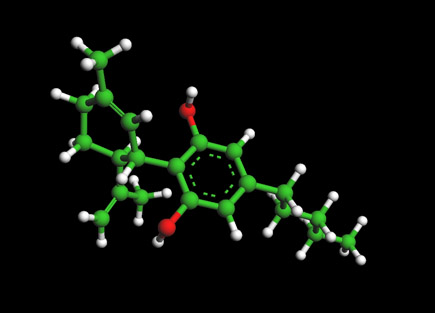Sulforaphane Molecule-- Anti-Aging and role in Cancer
Sulforaphane, an isothiocyanate from broccoli, is one of the most potent food-derived anticarcinogens. ... see below--
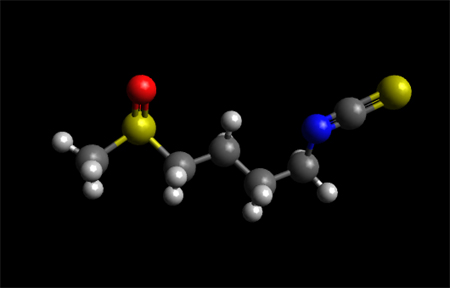
Ball and Stick Model for Sulforaphane Molecule
Sulforaphane Molecule (above) Ball-and-stick. For 3D Jsmol File
Molecular formula C6H11NOS2
Molar mass 177.29 g/mol
Sulforaphane Molecular Structure

Overview of Sulforaphane
Sulforaphane (sulphoraphane in British English) is a compound within the isothiocyanate group of organosulfur compounds. It is obtained from cruciferous vegetables such as broccoli, Brussels sprouts, and cabbages. It is produced when the enzyme myrosinase transforms glucoraphanin, a glucosinolate, into sulforaphane upon damage to the plant (such as from chewing), which allows the two compounds to mix and react.
Young sprouts of broccoli and cauliflower are particularly rich in glucoraphanin.
Glucoraphanin Molecular Structure
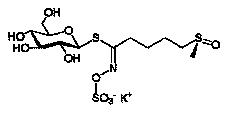
Molecular Formula --C12H23NO10S3
Conversion of Glucoraphanin to Sulforaphanes
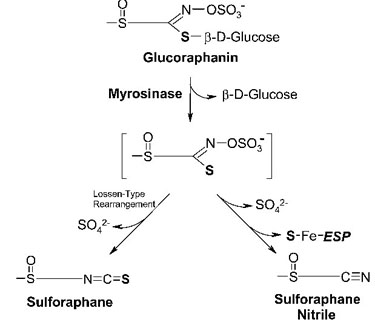
Formation of Sulforaphane and Sulforapane Nitrile from Glucoraphanin. Heating broccoli sprouts to 60 degrees C causes inactivation of ESP complex and favors a higher production of bioactive Sulforaphane. Image from: Heating decreases epithiospecifier protein activity and increases sulforaphane formation in broccoli. Nathan V. Matusheski, John A Juvik, Elizabeth H. Jeffery.
"The most characteristic feature of sulforaphane is its high chemical reactivity due to the electrophilicity of the central carbon of the isothiocyanate (—NCS) group. ...At high or neutral pH, sulforaphane will be the primary product of glucoraphanin hydrolysis. In contrast, at acidic pH, or in the presence of Fe2+, with the enzyme epithiospecifier protein (ESP), the production of a nitrile (sulforaphane nitrile), which is less bioactive, will be favored.." From --KEAP1 and done? Targeting the NRF2 pathway with sulforaphane.
About Sulforaphane Nitrile
"...A number of studies have demonstrated that sulforaphane yield from glucoraphanin is low, and that a non-bioactive nitrile analog, sulforaphane nitrile, is the primary hydrolysis product when plant tissue is crushed at room temperature...nitrile formation from glucosinolates is controlled by a heat-sensitive protein, epithiospecifier protein (ESP), a non-catalytic cofactor of myrosinase...Heating fresh broccoli florets or broccoli sprouts to 60 degrees C prior to homogenization simultaneously increased sulforaphane formation and decreased sulforaphane nitrile formation... see full abstract. This suggest that those eating broccoli sprouts for health benefits should heat the sprouts for 10 minutes at 60C prior to homgenization.
Abstracts:
18 March 2022 Sulforaphane exhibits antiviral activity against pandemic SARS-CoV-2 and seasonal HCoV-OC43 coronaviruses in vitro and in mice
"...We evaluated the antiviral activity of sulforaphane (SFN), the principal biologically active phytochemical derived from glucoraphanin, the naturally occurring precursor present in high concentrations in cruciferous vegetables. SFN inhibited in vitro replication of six strains of SARS-CoV-2, including Delta and Omicron, as well as that of the seasonal coronavirus HCoV-OC43. Further, SFN and remdesivir interacted synergistically to inhibit coronavirus infection in vitro. Prophylactic administration of SFN to K18-hACE2 mice prior to intranasal SARS-CoV-2 infection significantly decreased the viral load in the lungs and upper respiratory tract and reduced lung injury and pulmonary pathology compared to untreated infected mice..." see Nature Journal full Abstract
2 April 2019 --Sulforaphane - role in aging and neurodegeneration.
"...In the last several years, numerous molecules derived from plants and vegetables have been tested for their antioxidant, anti-inflammatory, and anti-aging properties. One of them is sulforaphane (SFN), an isothiocyanate present in cruciferous vegetables. SFN activates the antioxidant and anti-inflammatory responses by inducing Nrf2 pathway and inhibiting NF-κB. It also has an epigenetic effect by inhibiting HDAC and DNA methyltransferases and modifies mitochondrial dynamics. Moreover, SFN preserves proteome homeostasis (proteostasis) by activating the proteasome, which has been shown to lead to increased cellular lifespan and prevent neurodegeneration. In this review, we describe some of the molecular and physical characteristics of SFN, its mechanisms of action, and the effects that SFN treatment induces in order to discuss its relevance as a "miraculous" drug to prevent aging and neurodegeneration..." source.
25 October 2015 Sulforaphane Protects against Cardiovascular Disease via Nrf2 Activation
"...Cardiovascular disease (CVD) causes an unparalleled proportion of the global burden of disease and will remain the main cause of mortality for the near future. Oxidative stress plays a major role in the pathophysiology of cardiac disorders. Several studies have highlighted the cardinal role played by the overproduction of reactive oxygen or nitrogen species in the pathogenesis of ischemic myocardial damage and consequent cardiac dysfunction. Isothiocyanates (ITC) are sulfur-containing compounds that are broadly distributed among cruciferous vegetables. Sulforaphane (SFN) is an ITC shown to possess anticancer activities by both in vivo and epidemiological studies. Recent data have indicated that the beneficial effects of SFN in CVD are due to its antioxidant and anti-inflammatory properties. SFN activates NF-E2-related factor 2 (Nrf2), a basic leucine zipper transcription factor that serves as a defense mechanism against oxidative stress and electrophilic toxicants by inducing more than a hundred cytoprotective proteins, including antioxidants and phase II detoxifying enzymes. This review will summarize the evidence from clinical studies and animal experiments relating to the potential mechanisms by which SFN modulates Nrf2 activation and protects against CVD..." source
6 June 2018 -- Anticancer Activity of Sulforaphane: The Epigenetic Mechanisms and the Nrf2 Signaling Pathway
Sulforaphane (SFN), a compound derived from cruciferous vegetables that has been shown to be safe and nontoxic, with minimal/no side effects, has been extensively studied due to its numerous bioactivities, such as anticancer and antioxidant activities. SFN exerts its anticancer effects by modulating key signaling pathways and genes involved in the induction of apoptosis, cell cycle arrest, and inhibition of angiogenesis. SFN also upregulates a series of cytoprotective genes by activating nuclear factor erythroid-2- (NF-E2-) related factor 2 (Nrf2), a critical transcription factor activated in response to oxidative stress; Nrf2 activation is also involved in the cancer-preventive effects of SFN. Accumulating evidence supports that epigenetic modification is an important factor in carcinogenesis and cancer progression, as epigenetic alterations often contribute to the inhibition of tumor-suppressor genes and the activation of oncogenes, which enables cells to acquire cancer-promoting properties. Studies on the mechanisms underlying the anticancer effects of SFN have shown that SFN can reverse such epigenetic alterations in cancers by targeting DNA methyltransferases (DNMTs), histone deacetyltransferases (HDACs), and noncoding RNAs. Therefore, in this review, we will discuss the anticancer activities of SFN and its mechanisms, with a particular emphasis on epigenetic modifications, including epigenetic reactivation of Nrf2. source
November 2017 -- KEAP1 and done? Targeting the NRF2 pathway with sulforaphane
"Many putative cellular targets are affected by sulforaphane although only one, KEAP1-NRF2 signaling, can be considered a validated target at this time. The transcription factor NRF2 is a master regulator of cell survival responses to endogenous and exogenous stressors....Sulforaphane, as a pure chemical, protects against chemical-induced skin, oral, stomach, colon, lung and bladder carcinogenesis and in genetic models of colon and prostate carcinogenesis. In many of these settings the antitumorigenic efficacy of sulforaphane is dampened in Nrf2-disrupted animals. Broccoli preparations rich in glucoraphanin or sulforaphane exert demonstrable pharmacodynamic action in over a score of clinical trials. Measures of NRF2 pathway response and function are serving as guideposts for the optimization of dose, schedule and formulation as clinical trials with broccoli-based preparations become more commonplace and more rigorous in design and implementation...This review summarizes the chemical biology of sulforaphane as an inducer of NRF2 signaling and efficacy as an inhibitor of carcinogenesis. It also provides a summary of the current findings from clinical trials using a suite of broccoli sprout preparations on a series of short-term endpoints reflecting a diversity of molecular actions...Three-day-old broccoli sprouts contain 10–100 times higher levels of glucoraphanin than do mature broccoli..." full text
26 October 2017--Sulforaphane reactivates cellular antioxidant defense by inducing Nrf2/ARE/Prdx6 activity during aging and oxidative stress
Upon oxidative stress and aging, Nrf2 (NFE2-related factor2) triggers antioxidant defense genes to defends against homeostatic failure. Using human(h) or rat(r) lens epithelial cells (LECs) and aging human lenses, we showed that a progressive increase in oxidative load during aging was linked to a decline in Prdx6 expression. DNA binding experiments using gel-shift and ChIP assays demonstrated a progressive reduction in Nrf2/ARE binding (−357/−349) of Prdx6 promoter. The promoter (−918) with ARE showed a marked reduction in young vs aged hLECs, which was directly correlated to decreased Nrf2/ARE binding. A Nrf2 activator, Sulforaphane (SFN), augmented Prdx6, catalase and GSTπ expression in dose-dependent fashion, and halted Nrf2 dysregulation of these antioxidants. SFN reinforced Nrf2/DNA binding and increased promoter activities by enhancing expression and facilitating Nrf2 translocalization in nucleus. Conversely, promoter mutated at ARE site did not respond to SFN, validating the SFN-mediated restoration of Nrf2/ARE signaling. Furthermore, SFN rescued cells from UVB-induced toxicity in dose-dependent fashion, which was consistent with SFN’s dose-dependent activation of Nrf2/ARE interaction. Importantly, knockdown of Prdx6 revealed that Prdx6 expression was prerequisite for SFN-mediated cytoprotection. Collectively, our results suggest that loss of Prdx6 caused by dysregulation of ARE/Nrf2 can be attenuated through a SFN, to combat diseases associated with aging. source.
1 October 2010 -- Allyl isothiocyanate-rich mustard seed powder inhibits bladder cancer growth and muscle invasion
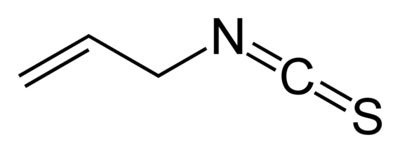
Allyl Isothocyanate Molecular Structure
Allyl isothiocyanate (AITC), which occurs in many common cruciferous vegetables, was recently shown to be selectively delivered to bladder cancer tissues through urinary excretion and to inhibit bladder cancer development in rats. The present investigation was designed to test the hypothesis that AITC-containing cruciferous vegetables also inhibit bladder cancer development. We focused on an AITC-rich mustard seed powder (MSP-1). AITC was stably stored as its glucosinolate precursor (sinigrin) in MSP-1. Upon addition of water, however, sinigrin was readily hydrolyzed by the accompanying endogenous myrosinase. This myrosinase was also required for full conversion of sinigrin to AITC in vivo , but the matrix of MSP-1 had no effect on AITC bioavailability. Sinigrin itself was not bioactive, whereas hydrated MSP-1 caused apoptosis and G 2 /M phase arrest in bladder cancer cell lines in vitro . Comparison between hydrated MSP-1 and pure sinigrin with added myrosinase suggested that the anticancer effect of MSP-1 was derived principally, if not entirely, from the AITC generated from sinigrin. In an orthotopic rat bladder cancer model, oral MSP-1 at 71.5 mg/kg (sinigrin dose of 9 μmol/kg) inhibited bladder cancer growth by 34.5% ( P < 0.05) and blocked muscle invasion by 100%. Moreover, the anticancer activity was associated with significant modulation of key cancer therapeutic targets, including vascular endothelial growth factor, cyclin B1 and caspase 3. On an equimolar basis, the anticancer activity of AITC delivered as MSP-1 appears to be more robust than that of pure AITC. MSP-1 is thus an attractive delivery vehicle for AITC and it strongly inhibits bladder cancer development and progression. see full publication
See also:
8 May 2019 -- Nrf2 in cancers: A double-edged sword.
The Nrf2/Keap1 pathway is an important signaling cascade responsible for the resistance of oxidative damage induced by exogenous chemicals. It maintains the redox homeostasis, exerts anti-inflammation and anticancer activity by regulating its multiple downstream cytoprotective genes, thereby plays a vital role in cell survival. Interestingly, in recent years, accumulating evidence suggests that Nrf2 has a contradictory role in cancers. Aberrant activation of Nrf2 is associated with poor prognosis. The constitutive activation of Nrf2 in various cancers induces pro-survival genes and promotes cancer cell proliferation by metabolic reprogramming, repression of cancer cell apoptosis, and enhancement of self-renewal capacity of cancer stem cells. More importantly, Nrf2 is proved to contribute to the chemoresistance and radioresistance of cancer cells as well as inflammation-induced carcinogenesis. A number of Nrf2 inhibitors discovered for cancer treatment were reviewed in this report. These provide a new strategy that targeting Nrf2 could be a promising therapeutic approach against cancer. This review aims to summarize the dual effects of Nrf2 in cancer, revealing its function both in cancer prevention and inhibition, to further discover novel anticancer treatment. source
9 July 2018 --NRF2 and the Hallmarks of Cancer
"...The transcription factor NRF2 is the master regulator of the cellular antioxidant response. Though recognized originally as a target of chemopreventive compounds that help prevent cancer and other maladies, accumulating evidence has established the NRF2 pathway as a driver of cancer progression, metastasis, and resistance to therapy. Recent studies have identified new functions for NRF2 in the regulation of metabolism and other essential cellular functions, establishing NRF2 as a truly pleiotropic transcription factor. In this review, we explore the roles of NRF2 in the hallmarks of cancer, indicating both tumor suppressive and tumor-promoting effects..." ..full text
11 April 2019 -Potential Applications of NRF2 Inhibitors in Cancer Therapy
"...The NRF2/KEAP1 pathway represents one of the most important cell defense mechanisms against exogenous or endogenous stressors. Indeed, by increasing the expression of several cytoprotective genes, the transcription factor NRF2 can shelter cells and tissues from multiple sources of damage including xenobiotic, electrophilic, metabolic, and oxidative stress. Importantly, the aberrant activation or accumulation of NRF2, a common event in many tumors, confers a selective advantage to cancer cells and is associated to malignant progression, therapy resistance, and poor prognosis. Hence, in the last years, NRF2 has emerged as a promising target in cancer treatment and many efforts have been made to identify therapeutic strategies aimed at disrupting its prooncogenic role. By summarizing the results from past and recent studies, in this review, we provide an overview concerning the NRF2/KEAP1 pathway, its biological impact in solid and hematologic malignancies, and the molecular mechanisms causing NRF2 hyperactivation in cancer cells. Finally, we also describe some of the most promising therapeutic approaches that have been successfully employed to counteract NRF2 activity in tumors, with a particular emphasis on the development of natural compounds and the adoption of drug repurposing strategies..." source
Foods high in glucosinolates
Broccoli, Brussels sprouts, broccoli sprouts (3 day old broccoli sprouts contain 400x amount as regular broccoli), cabbages, and horseradish (has up to 10 times more glucosinolates than broccoli).
Anti-Aging and Senolytics Home Page
- What is Anti-Aging Medicine
- What is Senescence?
- What are Senolytics?
- About Caloric Restriction
- Mtor and Rapamycin
- The IKK/NF-κB signaling pathway in aging
- Exercise and Anti-Aging
- Meditation and Anti-Aging
SENOLYTIC AND ANTI-AGING MOLECULES
RAPAMYCIN ---The mechanistic target of rapamycin (mTOR) pathway has a central role in cell activation...
METFORMIN -- The diabetes drug metformin used by some for anti-aging may diminish benefits of aerobic exercise...
QUERCETIN-- AND WITH DASATINIB--The senolytic cocktail, dasatinib plus quercetin, which causes selective elimination of senescent cells...
FISETIN--Of the 10 flavonoids tested, fisetin was the most potent senolytic...
EGCG- The most active component of green tea....
NAD BOOSTERS --'...The cells of the old mice were indistinguishable from the young mice, after just one week of treatment...
SULFORAPHANE-- An isothiocyanate present in cruciferous vegetables activates antioxidant and anti-inflammatory responses by ...
UROLITHIN --Metabolite of Pomegranate compound with anti-aging effects passes human trial...
MITO-Q -- A water soluble fomr of CoQ10 that has excellent absorption and high bioavailability...
HONOKIOL - A bioactive natural product derived from Magnolia Bark have demonstrated ...
CURCUMIN AND ANALOGS -Recent research is focused on the design and synthesis of curcumin analogs as antiproliferative and anti-inflammatory agents...
BERBERINE --berberine has recently been reported to expand life span in Drosophila melanogaster, and attenuate premature cellular senescence
N-ACETYL-CYSTINE (NAC)--"...pretreatment with NAC increased glutathione levels in the older cells and largely helped offset that level of cell death..."
PIPERLONGUMINE - A natural product from the Long pepper with high bioavailability...
RESVERATROL AND PTEROTSILBINE -- Pterostilben chemically similar to resveratrol bute differs from resveratrol by exhibiting increased bioavailability (80% compared to 20% in resveratrol)
SPERMIDINE--Spermidine delays aging in humans ...
ALLICIN -- Allicin is a compound produced when garlic is crushed or chopped. ...
VITAMIN D3 -- Production of the active forms of Vitamin D are reduced by 50% as a result of an age-related decline
VITAMIN K-- evidence suggests vitamin K has an anti-inflammatory action
TOCOTRIENOL(AND WITH QUERCETIN) --Tocotrieniols have been found to exert a synergistic antitumor effect on cancer cells when given in combination....
HSP-90 INHIBITORS --As a novel class of senolytics
The Cannabidiol Molecule
Cannabidiol (CBD is the major non-psychoactive component of Cannabis and is being looked at by major drug and consumer companies for various medical and social uses.